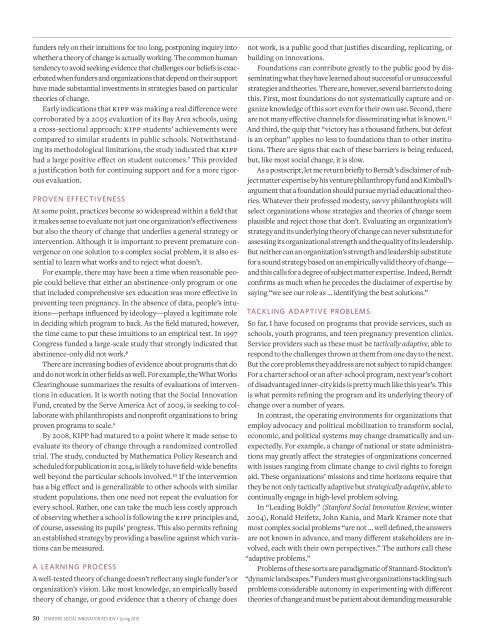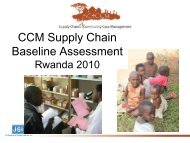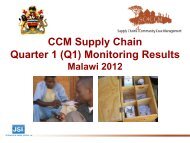The Power of Theories of Change By Paul Brest
The Power of Theories of Change By Paul Brest - SC4CCM
The Power of Theories of Change By Paul Brest - SC4CCM
- No tags were found...
You also want an ePaper? Increase the reach of your titles
YUMPU automatically turns print PDFs into web optimized ePapers that Google loves.
funders rely on their intuitions for too long, postponing inquiry into<br />
whether a theory <strong>of</strong> change is actually working. <strong>The</strong> common human<br />
tendency to avoid seeking evidence that challenges our beliefs is exacerbated<br />
when funders and organizations that depend on their support<br />
have made substantial investments in strategies based on particular<br />
theories <strong>of</strong> change.<br />
Early indications that kipp was making a real difference were<br />
corroborated by a 2005 evaluation <strong>of</strong> its Bay Area schools, using<br />
a cross-sectional approach: kipp students’ achievements were<br />
compared to similar students in public schools. Notwithstanding<br />
its methodological limitations, the study indicated that kipp<br />
had a large positive effect on student outcomes. 7 This provided<br />
a justification both for continuing support and for a more rigorous<br />
evaluation.<br />
Proven Effectiveness<br />
At some point, practices become so widespread within a field that<br />
it makes sense to evaluate not just one organization’s effectiveness<br />
but also the theory <strong>of</strong> change that underlies a general strategy or<br />
intervention. Although it is important to prevent premature convergence<br />
on one solution to a complex social problem, it is also essential<br />
to learn what works and to reject what doesn’t.<br />
For example, there may have been a time when reasonable people<br />
could believe that either an abstinence-only program or one<br />
that included comprehensive sex education was more effective in<br />
preventing teen pregnancy. In the absence <strong>of</strong> data, people’s intuitions—perhaps<br />
influenced by ideology—played a legitimate role<br />
in deciding which program to back. As the field matured, however,<br />
the time came to put these intuitions to an empirical test. In 1997<br />
Congress funded a large-scale study that strongly indicated that<br />
abstinence-only did not work. 8<br />
<strong>The</strong>re are increasing bodies <strong>of</strong> evidence about programs that do<br />
and do not work in other fields as well. For example, the What Works<br />
Clearinghouse summarizes the results <strong>of</strong> evaluations <strong>of</strong> interventions<br />
in education. It is worth noting that the Social Innovation<br />
Fund, created by the Serve America Act <strong>of</strong> 2009, is seeking to collaborate<br />
with philanthropists and nonpr<strong>of</strong>it organizations to bring<br />
proven programs to scale. 9<br />
<strong>By</strong> 2008, KIPP had matured to a point where it made sense to<br />
evaluate its theory <strong>of</strong> change through a randomized controlled<br />
trial. <strong>The</strong> study, conducted by Mathematica Policy Research and<br />
scheduled for publication in 2014, is likely to have field-wide benefits<br />
well beyond the particular schools involved. 10 If the intervention<br />
has a big effect and is generalizable to other schools with similar<br />
student populations, then one need not repeat the evaluation for<br />
every school. Rather, one can take the much less costly approach<br />
<strong>of</strong> observing whether a school is following the kipp principles and,<br />
<strong>of</strong> course, assessing its pupils’ progress. This also permits refining<br />
an established strategy by providing a baseline against which variations<br />
can be measured.<br />
A Learning Process<br />
A well-tested theory <strong>of</strong> change doesn’t reflect any single funder’s or<br />
organization’s vision. Like most knowledge, an empirically based<br />
theory <strong>of</strong> change, or good evidence that a theory <strong>of</strong> change does<br />
not work, is a public good that justifies discarding, replicating, or<br />
building on innovations.<br />
Foundations can contribute greatly to the public good by disseminating<br />
what they have learned about successful or unsuccessful<br />
strategies and theories. <strong>The</strong>re are, however, several barriers to doing<br />
this. First, most foundations do not systematically capture and organize<br />
knowledge <strong>of</strong> this sort even for their own use. Second, there<br />
are not many effective channels for disseminating what is known. 11<br />
And third, the quip that “victory has a thousand fathers, but defeat<br />
is an orphan” applies no less to foundations than to other institutions.<br />
<strong>The</strong>re are signs that each <strong>of</strong> these barriers is being reduced,<br />
but, like most social change, it is slow.<br />
As a postscript, let me return briefly to Berndt’s disclaimer <strong>of</strong> subject<br />
matter expertise by his venture philanthropy fund and Kimball’s<br />
argument that a foundation should pursue myriad educational theories.<br />
Whatever their pr<strong>of</strong>essed modesty, savvy philanthropists will<br />
select organizations whose strategies and theories <strong>of</strong> change seem<br />
plausible and reject those that don’t. Evaluating an organization’s<br />
strategy and its underlying theory <strong>of</strong> change can never substitute for<br />
assessing its organizational strength and the quality <strong>of</strong> its leadership.<br />
But neither can an organization’s strength and leadership substitute<br />
for a sound strategy based on an empirically valid theory <strong>of</strong> change—<br />
and this calls for a degree <strong>of</strong> subject matter expertise. Indeed, Berndt<br />
confirms as much when he precedes the disclaimer <strong>of</strong> expertise by<br />
saying “we see our role as … identifying the best solutions.”<br />
Tackling Adaptive Problems<br />
So far, I have focused on programs that provide services, such as<br />
schools, youth programs, and teen pregnancy prevention clinics.<br />
Service providers such as these must be tactically adaptive, able to<br />
respond to the challenges thrown at them from one day to the next.<br />
But the core problems they address are not subject to rapid changes:<br />
For a charter school or an after-school program, next year’s cohort<br />
<strong>of</strong> disadvantaged inner-city kids is pretty much like this year’s. This<br />
is what permits refining the program and its underlying theory <strong>of</strong><br />
change over a number <strong>of</strong> years.<br />
In contrast, the operating environments for organizations that<br />
employ advocacy and political mobilization to transform social,<br />
economic, and political systems may change dramatically and unexpectedly.<br />
For example, a change <strong>of</strong> national or state administrations<br />
may greatly affect the strategies <strong>of</strong> organizations concerned<br />
with issues ranging from climate change to civil rights to foreign<br />
aid. <strong>The</strong>se organizations’ missions and time horizons require that<br />
they be not only tactically adaptive but strategically adaptive, able to<br />
continually engage in high-level problem solving.<br />
In “Leading Boldly” (Stanford Social Innovation Review, winter<br />
2004), Ronald Heifetz, John Kania, and Mark Kramer note that<br />
most complex social problems “are not … well defined, the answers<br />
are not known in advance, and many different stakeholders are involved,<br />
each with their own perspectives.” <strong>The</strong> authors call these<br />
“adaptive problems.”<br />
Problems <strong>of</strong> these sorts are paradigmatic <strong>of</strong> Stannard-Stockton’s<br />
“dynamic landscapes.” Funders must give organizations tackling such<br />
problems considerable autonomy in experimenting with different<br />
theories <strong>of</strong> change and must be patient about demanding measurable<br />
50 Stanford Social Innovation Review • Spring 2010






